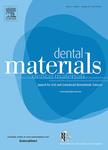版权所有:内蒙古大学图书馆 技术提供:维普资讯• 智图
内蒙古自治区呼和浩特市赛罕区大学西街235号 邮编: 010021

作者机构:Univ Dublin Trinity Coll Dublin Dent Sch & Hosp Div Oral Biosci Mat Sci Unit Dublin 2 Ireland
出 版 物:《DENTAL MATERIALS》 (牙科材料)
年 卷 期:2009年第25卷第2期
页 面:214-220页
核心收录:
学科分类:1003[医学-口腔医学] 0805[工学-材料科学与工程(可授工学、理学学位)] 10[医学]
主 题:Wear resistance Resin-based composites Halogen irradiance optical profilometry
摘 要:Objective. The Oregon Health Science University (OHSU) four-chamber oral wear simulator was used to examine the impact of halogen irradiance on the short- and long-term wear behavior of four-methacrylate resin-based composites (RBCs). The hypothesis proposed was that exacerbated wear would occur following the long-term wear of RBCs irradiated under non-optimized irradiance conditions. Methods. Disc-shaped specimens (12.0 +/- 0.1 mm diameter and 2.0 +/- 0.1 mm height) of each RBC were prepared at irradiances of 650 +/- 14, 530 +/- 8, 420 +/- 14, 350 +/- 8, 270 +/- 8, 230 +/- 14, 190 +/- 8, and 150 +/- 8 mW/cm(2), respectively Short-term three-body wear simulation was carried out for 50,000 cycles and long-term was performed up to 500,000 cycles. The wear facets were analyzed using a non-contact optical profilometer. One-, two-, and three-way analyses of variance (ANOVA) were made at P = 0.05, guided as necessary by Tukeys correction in multiple partial analyses of the mean total volumetric wear and mean maximum wear depth. Results. For the short-term wear resistance, the two-way ANOVA identified no significant difference in the mean total volumetric wear (P = 0.188) although the mean total wear depth was identified to be significant (P = 0.024). The long-term wear resistance for the mean total volumetric wear identified significant differences for each RBC at varying irradiances with the number of cycles but not for the mean maximum wear depth. Significance. The increased number of ploughing actions of the antagonist on the RBC (long-term) results in increased friction which would be expected to play a major role in the wear process. The significant increase in the mean total volumetric wear, but not the mean maximum wear depth, observed over time which is exacerbated at reduced halogen irradiances emphasizes the arguments of DeLong for the employment of volume for evaluating material loss due to wear following in vitro wear simulation of RBCs. (c) 2008 Academy of De